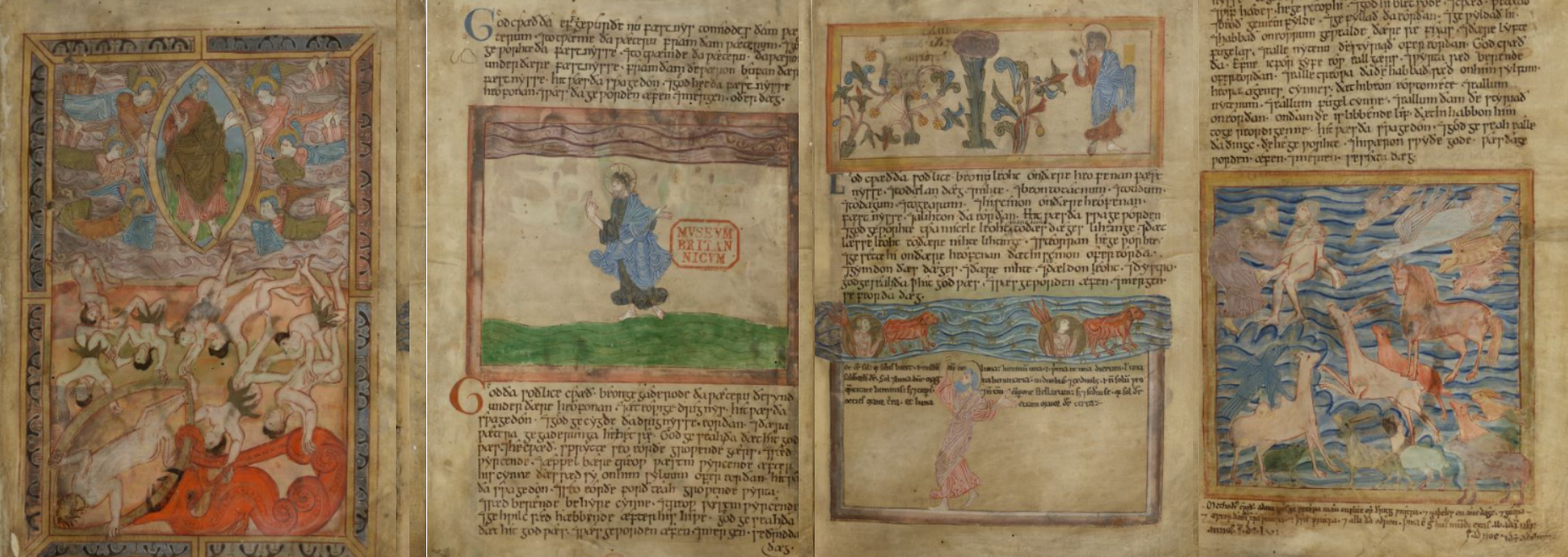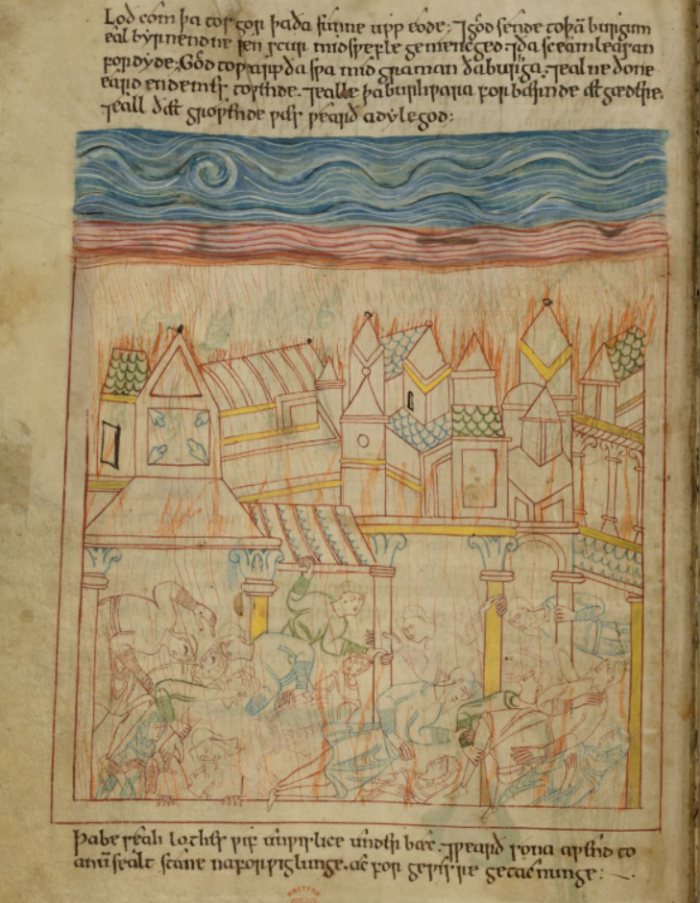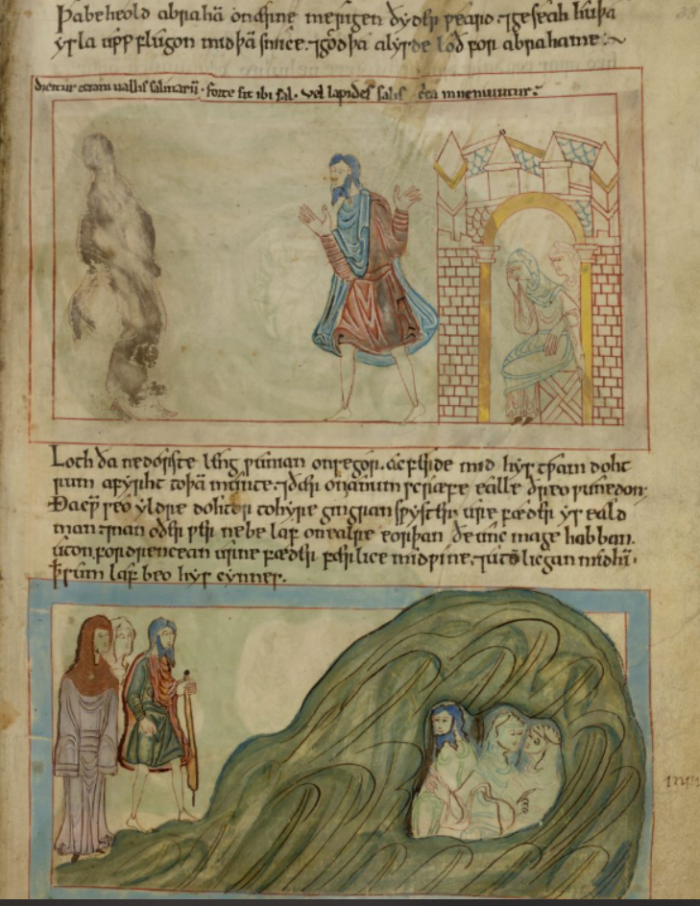Old English Hexateuch
Old English Hexateuch
The first English vernacular translation of the first six books of the Old Testament
by John Henry Chukwudi
Formal Description
| Alternative Title | Altenglischer Hexateuch |
| Type | Manuscript on parchment |
| Size / Format | 312 pages / 32.5 × 21.5 cm |
| Origin | United Kingdom |
| Date | 2nd quarter of 11th – 2nd half of 12th century |
| Epochs | High Middle Ages Early Middle Ages |
| Style | Romanesque Insular |
| Genre | Bibles / Gospels |
| Language | English Latin |
| Script | Insular minuscule |
| Ownership | British Library |

The value given to the Book
Between 1025 and 1050, the first English vernacular translation of the Hexateuch, the first six books of the Hebrew Bible, was undertaken by a team of Anglo-Saxon monks under the supervision of Abbot Ælfric of Eynsham. Seven manuscripts with the translation survive to the present, the most famous of which is the richly illuminated codex stored in the British Library under the shelfmark Cotton MS Claudius B. iv. The so-called “Old English Hexateuch” was compiled at St. Augustine’s Abbey in Canterbury and other texts in both Latin and English were appended to the manuscript during the 12th century, often using blank spaces left for miniatures that were never executed.
The text is adorned by 394 pen and ink drawings containing 550 scenes including 12 full-page miniatures at various stages of completion. Scenes from the Old Testament are thus set in the everyday life of Anglo-Saxon England, making it an important historical source on contemporary life.
In this book, the miniatures are richly coloured and detailed, especially with regard to the garment fall of folds. Peculiarities of the artwork include figures with blue hair, peculiar architecture, and tents with colourful stripes. Many of the miniatures are in varying stages of completion: those towards the beginning of the manuscript are fully finished while later miniatures are often incomplete, with some elements showing pen outlines that have not been coloured in, offering insights into the manuscript’s creation.
This nearly one-thousand-year-old manuscript is thus a precious specimen of both Anglo-Saxon theology and Old English linguistics.
Purpose of the Book
One of the various purposes of this book is elaborated in the preface written by Ælfric of Eynsham (ca. 955 – ca. 1010), which he addressed to the ealdorman and historian Æthelwærd (d. ca. 998), the chief benefactor of St. Augustine’s Abbey in Canterbury. In his writing, he used the medium to reveal his new discovery that the practices of the ancient Israelites are not acceptable to Christians, especially to the Anglo-Saxons as at that time.
In this book, Ælfric did not translate the Latin word-for-word but attempted to encapsulate its meaning instead, which yielded a more natural and readable Old English text with the intention of keeping it simple.
This book promotes both Anglo-Saxon theology and Old English linguistics, and the conservation of the Old English vernacular language.
Destruction of Sodomites and Lots Wife (Genesis 19:17)
Pages 33 and 34 of this bible, portrays a drawing of the event that was recorded In the book of Genesis 19, where God revealed to Abraham that Sodom and Gomorrah are to be destroyed for their grave sin (18:20). Abraham pleads for the lives of any righteous people living there, especially the lives of his nephew, Lot, and his family. Abraham seems to negotiate with God on behalf of the righteous in the two cities. Two Angels, appearing as men, are sent to Lot in Sodom but they found only Lot and his family as righteous among the inhabitants, the angels warn Lot to quickly evacuate the city and not look back. As they flee the destruction, Lot’s wife looks back upon the city and is turned into a pillar of salt (19:12–29).
In the illustration below, note the rather anachronistic architecture! and the second illustration as one of Lot’s daughters seems to be making a facepalm (2nd image)!
Inspired Paintings from the event in Genesis 19:17
This masterpiece could have inspired some of the classic painters between the 12th to 19th Centuries as indicated in the interactive visual display below:
Perspectives from the account of Genesis 19:17
According to Verrett (2021), He revealed that even to this day, major English writers like John Milton, Andrew Marvell, Lord Byron, Charlotte Brontë, William Blake, D.H. Lawrence, and James Joyce debated what it meant that she turned to a pillar of salt. Questions like; Did she turn into a physical rock formation? Was she evaporated? There is no solid conclusion.
However, there is a rock column near the Dead Sea at Mount Sodom in Israel which is around the valley where Lot’s family was fleeing that some venerate as Lot’s wife, though it is more myth than anything substantiated by history or the Bible.
When we relate this text to the New Testament (Book of Luke) as it quotes that “It will be just like this on the day the Son of Man is revealed. On that day no one who is on the roof of his house, with his goods inside, should go down and get them. Likewise, no one in the field should go back for anything. Remember Lot’s wife! Whoever tries to keep his life will lose it, and whoever loses his life will preserve it. I tell you, on that night two people will be in one bed; one will be taken and the other left. Two women will be grinding grain together; one will be taken and the other left.” – Luke 17:30-35

For further reading of this great masterpiece, please visit the digitalized published copy.
Works referred to:
Crawford, S. J. (ed.). The Old English Version of the Heptateuch, Ælfric’s Treatise on the Old and New Testament and His Preface to Genesis. Early English Text Society OS 160 (London, 1922).
Dodwell, C.R., and P. Clemoes (eds.). The Old English Illustrated Hexateuch: British Museum Cotton Claudius B. iv, Early English Manuscripts in Facsimile 18 (Copenhagen, 1974).
Old English Hexateuch. (2022, May 7). In Wikipedia. https://en.wikipedia.org/wiki/Old_English_Hexateuch
Verrett, B. (2021, October 27). Who was lot’s wife and why did she turn into a pillar of salt? – topical studies. biblestudytools.com. Retrieved November 8, 2022, from https://www.biblestudytools.com/bible-study/topical-studies/who-was-lots-wife-and-why-did-she-turn-into-a-pillar-of-salt.html





